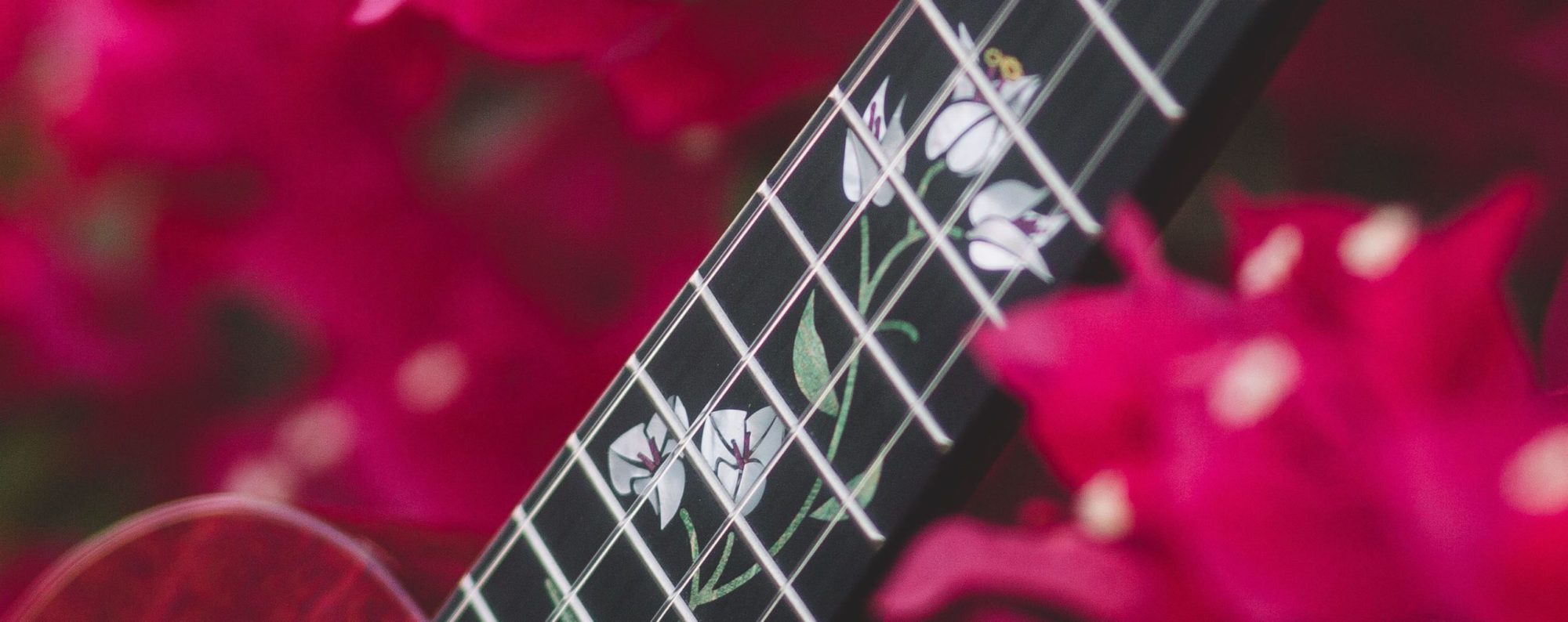The 30-Day Uke Challenge by Bernadette Teaches Music is a great place to start.
Once you are comfortable with that, try the 30-Day Uke Song Challenge.
Additionally, make a list of some songs which you really love and are easy to play.
Have fun, be patient and be kind to yourself along the journey.
It’s normal to get blisters, aches and cramps in the beginning of your ukulele journey. Try playing slowly and gently. In time, the pain will diminish as your fingertips develop calluses and you develop muscle memory.
It takes a while for new strings to stretch and settle in. You need to re-tune your new uke every 5 minutes but keep playing and let it warm up to you. Also, try pulling the strings gently the first few times to help them stretch faster.
You can hold your ukulele in the right position without a strap. However, it does increase mobility of both your hands. The choice is completely yours – try both and decide what works best for you.
Solid wooden ukuleles can warp or crack under extreme dryness. Even laminate ukes can warp under radical temperature.
The ideal humidity level for your uke is 40-50%.
You need to get a humidifier if your ukulele is not
kept in an environment where the humidity level is around that range.
It’s the ability of your instrument to stay in tune, whether you are plucking open strings or fretting. You know the uke has bad intonation when it doesn’t sound right, regardless of tuning it.
Intonation related problems can be caused by the string quality, fret positioning, action at the nut or saddle or neck alignment. If your uke is not sounding right, the best approach is to have it checked by a luthier.ple Description
If your strings are wearing out (check the area where the strings come in contact with the frets) or you experience loss of tone, it’s time to get new strings.
Ukuleles traditionally are strung with high-G strings. In this case, the G string is tuned as G4 which is higher than C4 (the string right next to your Gstring).
The low-G will be one octave lower than the high-G string (G3 instead of G4). In this case, you will get a much deeper and fuller sound.
All chord shapes remain the same for both low and high-G strings.
The metronome is a great tool to help you maintain your timing throughout a performance.
Practicing with a metronome will also guide you to make smoother chord transitions and improve your speed.
Standard tuning for the baritone ukulele is DGBE.
The chords for a song will remain the same but the chord shapes are different.
The metronome is a great tool to help you maintain your timing throughout a performance.
Practicing with a metronome will also guide you to make smoother chord transitions and improve your speed.
If you are asking whether you should get the uke that you have been eyeing, then the answer is always a yes!
On a more serious note, the type of wood, the action, smoothness of the fretboard, the uke’s weight and size can impact the sound quality and playability.
So yes, an upgrade can help you get the sound you desire.
Nevertheless, the first thing to sound betteris to practice enough to get better at playing your instrument.
NOPE!
The ukulele is a 4-string instrument with the standard tuning of GCEA, whereas the guitar has 6 strings tuned as EADGBE. They also sound very different from each other.
There is no one set way to determine a strumming pattern, but here’s what I do:
Listen to the song multiple times to really get it in my head, determine its rhythm and groove, look out for percussions and how the groove is shaped by heavier or lighter strums and finally try to replicate that groove.
Both can be helpful. A wider nut means greater space between the strings, so less chance of muting a string unintentionally.
The scale length invariably impacts on the nature of the sound produced - pitch, volume and tone. The choice of scale length should be dependent on the type of sound you want to make. Check out our past editions of ‘Buyers Guide’ if you wish to know more.
This is an overall check at the build, intonation and playability of an ukulele.
It’s when luthiers fix any wood defects, neck alignment, action, fret defects or
anything that might need some tweaking to ensure a buzz-free, comfortable and in-tune playing experience.
It’s the Ukulele Acquisition Syndrome.
Fear not, here’s a formula you can use:
No. of Ukes Required = N+1
(where N is the no. of ukes currently owned)
On a serious note, ask yourself the question, “Is it more worthwhile buying a lot
of cheaper ukes or holding back a bit and spending all that money on a very good one?”
The basic rhythm of the song should be the thing that dictates the strumming pattern. If you listen to a song, sing along and tap your foot to it. Think about when you are tapping.
That’s a pointer to how you strum it. If you can tap your foot to it, you can feel
the beat of the song. If you can feel it, you can play it!
The must-have while starting out is a tuner. Also, a strap will help alleviate
some of the stress of holding a uke in place. Other accessories to consider,
based on your preference, are capos, gig bags, uke stands, picks, cleaning
cloth and humidifiers.
It is best to keep the cleaning ritual simple.
Just wipe it with a microfiber cleaning cloth. You can very slightly dampen the cloth with water, but make sure to rinse off any dampness with a dry cloth afterwards. This bit is highly debated, but for a gloss-finish uke you can use a small amount of guitar polish on the body. However, experts say it’s best to not use such products on the fretboard.
It’s wise to choose a trustworthy brand and dealer. You MUST check user-reviews of the ukulele, the dealer and the deal itself.
In addition, get a clear idea on the return policy before making the purchase. ‘Got A Ukulele’ has detailed, unbiased reviews of many popular ukes, so it’s worth checking those out.
Metronome is a device that generates a steady beat per minute (BPM). It’s a great tool to develop your sense of rhythm and maintaining the desired rhythm throughout a song. You can set the BMP on your metronome as per requirement and play in time with the tick-tock sound it generates. It’s also a life saver when you want to work on increasing your strumming or fingerpicking speed.
Ah! We’ve all been there! First, hold your chord position and check which string is buzzing. Wiggle your fretting fingers around to see if you are unconsciously muting a string. Also, try fretting closer to the fret wire to get clearer sound e.g. for playing a C chord, your finger should be placed just above the 3rd fret. If the problem persists, check if your uke’s neck is warped, the frets are uneven or the string action is too low. In these cases, it is best to have the uke fixed by a luthier.
Uke sizes are correlated to the sound it produces rather than playability. Personally, for a newbie (child or adult), I’d recommend a concert. It’s medium in size and has all 18 frets with good fret width to get started on strumming or fingerpicking. To know more, please read Dave Thorpe’s article, “Size Matters” on our magazine’s 1st issue. You can also check out the YouTube video by Uke Like The Pros named “Ukulele Sizes and What is Best For You” to get further insights.
It has no cure, my friend! But you can consider saving up and getting a REALLY good uke that you wouldn’t want to ever put down 😛
It is when the saddle has notches to minutely adjust the string length and get accurate intonation. Intonation of a stringed instrument depends on precise measurements and there are multiple factors in play besides the compensated saddle. Manufacturers may decide to focus on other features more to ensure desired intonation. A straight saddle will not go wrong if it is positioned correctly, however, a compensated saddle is more likely to be closer to perfection.
A 6-string uke can be played using the same chord shapes as a traditional uke. It will have an additional C and A string, so it will be GCCEAA. They will sound same as a 4-string uke, but fuller. A guitar is strung as EADGBE and so the chord shapes are different.
A baritone uke is tuned just like the first 4 strings of a guitar – DGBE. A guitarlele is basically a standard guitar with a capo on the 5th fret. So, it’s tuned as ADGCEA.

